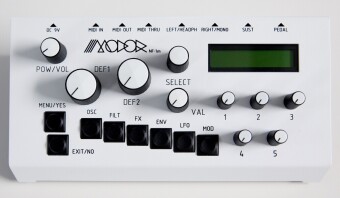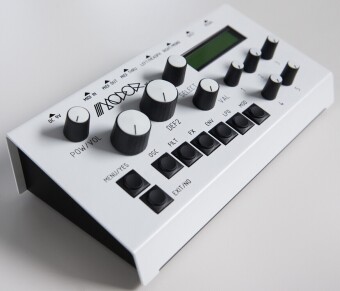The NF-1m is a more compact version of the polyphonic digital synthesizer NF-1. It includes all features of its big brother. The structure resembles a virtual analog. However, in terms of sound, the Modor guys go their own way.
The NF-1m is an eight-voice polyphonic digital synthesizer. Thanks to its thought-out synthesis system, this instrument delivers rich sounds ranging from classic to experimental. Besides standard waveforms, the oscillators offer additive and FM synthesis algorithms, filtered noise and a chip tune generator. For processing audio material, there’s not only a -12 dB multimode filter, but a Formant filter with morphing function as well. – Great for producing vocal sounds. The effects section includes a delay and a flanger / chorus. The modulation department is very flexible, thanks to a routing matrix. Subjectively speaking, the biggest highlights are grainy pads, noisy atmospheres, choir sounds, shimmering leads and retro drums.
The NF-1m comes equipped with three identical oscillators, a white noise source and a ring modulator (Osc 2 x Osc 3). A mixer allows users to combine all signals generated by the synthesizer.
Oscillators:
The oscillators feature coarse and fine tune parameters. Additionally, the modulation intensity of LFO and envelope can be edited. Ten waveforms respectively synthesis algorithms are available. The functionality of the Mod parameter differs from algorithm to algorithm. The NF-1m features the following waveforms respectively types of synthesis:
- Three standard waves: Saw, triangle and pulse. The Mod parameter controls wave shaping or pulse width.
- SYNC OSC: Generates a synchronized square wave with decaying amplitude. The Mod parameter determines the frequency of the sync oscillator.
- ADD: Additive algorithm. With the Mod parameter, users can set the distance between the harmonics.
- SONAR: White noise, processed by a bandpass filter. The Mod parameter controls the filter resonance. Thanks to key tracking, the Bandpass follows the pitch of incoming note data.
- WND: Wind-like, tonal noise. The Mod parameter controls the cutoff frequency of a high-pass filter.
- ARC: A chip tune generator, great for creating drums reminiscent of old video games. Again, the Mod parameter controls the cutoff frequency of a high-pass filter.
- FM: 2-operator sine FM. Operator 1 modulates operator 2. The Mod parameter determines the FM intensity.
- FBFM: 2 operator sine FM with feedback. Operator 1 modulates itself plus operator 2. The Mod parameter sets the FM intensity.
The Mod parameter can be influenced via LFO1 and all three envelopes. While one of the FM algorithms is active, the FM Modulator and FM Carrier menu entries can be used to set the operators’ frequency ratios.
Filter:
The NF-1 comes equipped with two completely different filters, which can be wired in parallel or in series.
- The first filter is a resonant multimode filter with a slope of -12 dB per octave. It features low-pass, band-pass, high-pass and notch modes. The resonance goes up to self-oscillation. The filter is followed by a great sounding distortion, which provides an aggressive, slightly 303-ish character.
- The second filter features a rather unusual design. It is a formant filter, adding a vocal character to sounds by emphasizing certain harmonics, the so-called formants. It is awesome for pad sounds and for creating “choir” sounds. Combined with the integrated delay effect (see below), it produces funny speech sounds. Ten vocal settings with different formants are available. The programs can be arranged in groups of three.
Effects:
The NF-1 is equipped with two effect generators, a chorus / flanger and a delay, both with individual control elements and dry / wet knobs.
- The chorus / flanger is a delay-based comb filter. A LFO with adjustable modulation depth and speed is used to get the filter moving. The feedback control can add classic or inverted, very odd sounding feedback.
- The delay offers a maximum time value of 750 milliseconds, feedback and a -12 dB low pass filter for damping high frequencies. It can be synchronized to an incoming MIDI clock.
Modulations:
The modulation department consists of three LFOs, a sample & hold generator and four ADSR-like envelopes with some additional features.
- LFO1 offers four waveforms (triangle, saw, square and sine). It is routed to the oscillators’ Mod parameters. In high-speed mode, the LFO can oscillate in the audio range.
- LFO2 comes equipped with the same features as LFO1, but is routed to the cutoff frequency of the multimode filter and the morph parameter of the formant filter. It can be synchronized to a MIDI clock.
- LFO3 is a global triangle LFO whose amplitude can be altered via the modulation wheel.
- The sample & hold generator’s frequency can be controlled independently of the LFOs. It is possible to smooth S&H values to avoid drastic parameter changes.
- The envelopes go far beyond the capabilities of typical ADSR modulators. – They could be described as multi-stage envelopes. L1 sets the modulators maximum level. The decay is split into two stages, which can be edited via the time parameters T2 and T3 as well as the level parameter L2. As with the oscillators, it is possible to edit several envelopes at once. The envelopes are pre-wired to the following parameters.
- ENV1: Pitch and Mod parameter of the first oscillator
- ENV2: Filter cutoff and Mod parameter of the second oscillator
- ENV3: Formant morph and Mod parameter of the third oscillator
- ENV4: Amplitude
Additionally to the routings described above, there is a matrix for doing other connections between modulation sources and targets. Several hundred sounds can be saved. All parameters are not only accessible on the device, but can also be controlled via MIDI.



